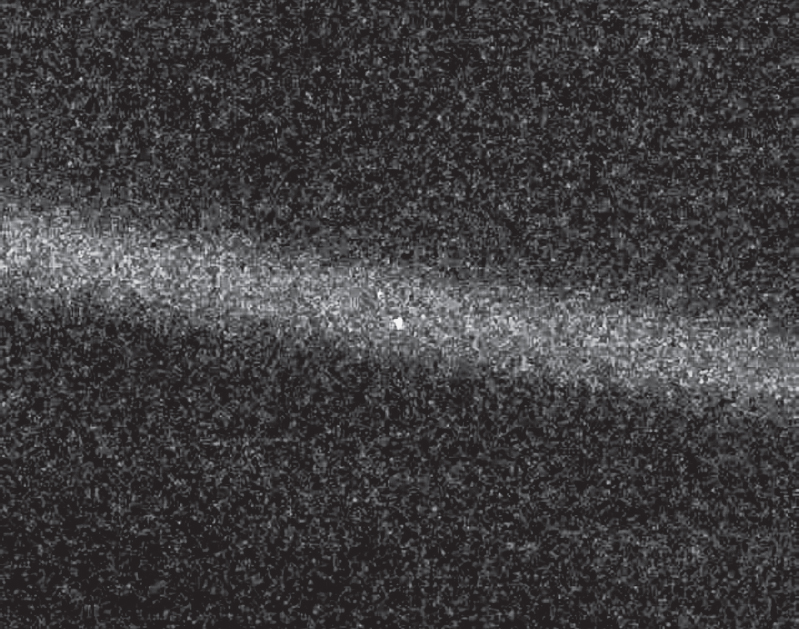Epilogue
When Voyager 1 flew by Jupiter in 1979 and by Saturn in 1980, the gravitational slingshots provided by these gas giants flung the spacecraft out of the Solar System at a blistering 17 km/s (a half billion kilometers per year). A decade later, after crossing the orbit of Pluto, the spacecraft looked back over its shoulder and snapped a family portrait of the Sun and her retinue of planets. From this distant vantage, some 6 billion kilometers away, the Earth hangs in the inky blackness of space, a pale blue dot not even a single pixel wide (fig. E.1).
Astrobiology provides us with an armchair equivalent of that perspective, the chance to step back and look at our home planet in the context of the rest of the Universe. Is that tiny speck, floating like a dust mote in a vastly larger cosmos, the only inhabited planet in the Solar System? In the Milky Way? In the observable Universe? On the one hand, the Universe is a mighty big place; it contains an estimated 50 sextillion (5 × 1022) stars (go back and stare at fig. P.1) and probably at least that many planets and moons. On the other hand, the best-founded theory of the origins of life, the RNA-world hypothesis, requires the spontaneous formation of RNA polymers that are so rare that the probability of their forming spontaneously dwarfs the number of stars in the Universe (see sidebar 5.1). And then there is the anthropic principle (see sidebar 2.3) to confuse things: if there were only one inhabited planet in our Universe, we questioning beings would necessarily find ourselves on that planet, and thus the existence of Earth as a habitable planet does not by any means prove that habitats—much less life—are common in the cosmos.

Figure E.1 You are here. That dot, floating in a beam of stray sunlight scattered into the camera, is our home planet as viewed on Valentine’s Day 1990 by Voyager 1 from a vantage point farther from the Sun than Pluto. (Image courtesy of NASA/JPL-Caltech)
Where does this leave us? Of course, it is always possible that life arose here on Earth through some more facile, more highly probable mechanism than those described in this book; there is certainly much that remains to be discovered. Indeed, we are reminded of a comment by J. B. S. Haldane, the man who coined the phrase primordial soup: “the Universe is not only queerer than we suppose, but queerer than we can suppose.”* Conversely, though, if life did arise through chemistry that we, more or less, currently understand, then the probabilities suggest that we most likely are alone in the Universe.
Obviously, we do not yet know the answer to the central question of whether life on Earth is an anomaly, and we must face the fact that it may be centuries before we find out—if we ever do. Still, it is perhaps helpful to look back: some 400 years ago, it took an enormous leap of the imagination for pioneering scientist Johannes Kepler to consider what the movement of the celestial bodies would look like to an observer based on the Moon. He addressed this question in a work of fiction, published posthumously as Somnium (“The Dream”). Thinking outside the box of his own limited planetary world enabled Kepler to develop the laws of planetary motion, which we still use today to predict the movements of the planets and to send our spacecraft to visit them. Kepler could not possibly have guessed how many centuries it would take for humans to make a trip to the Moon and explore the Solar System beyond.
Similarly, while we can think outside the box of our own limited planetary world to discover and understand planets even far beyond our Solar System, visiting them is as remote to us as visiting the Moon was to Kepler, if not more so. But, as we have shown in this book, even speculative considerations, provided that they are based on and constrained by the scientific knowledge we already have on hand, enlighten us about our place in the Universe. And, who knows? Perhaps someday we will have the ability to go and look for ourselves. Until then, as the only intelligent life we know of, all we humans can do is keep asking questions that further our understanding of our place in the Universe.
- * J. B. S. Haldane, Possible Worlds and Other Papers (London: Harper and Brothers, 1927), 286.